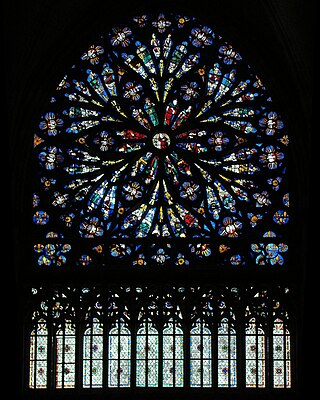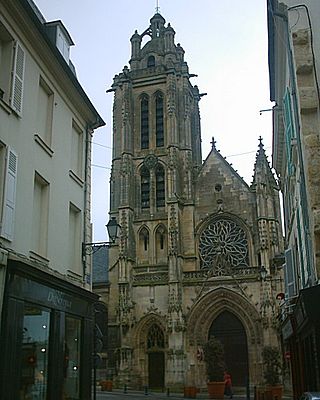
Gothic architecture is an architectural style that was prevalent in Europe from the late 12th to the 16th century, during the High and Late Middle Ages, surviving into the 17th and 18th centuries in some areas. It evolved from Romanesque architecture and was succeeded by Renaissance architecture. It originated in the Île-de-France and Picardy regions of northern France. The style at the time was sometimes known as opus Francigenum ; the term Gothic was first applied contemptuously during the later Renaissance, by those ambitious to revive the architecture of classical antiquity.
In French Gothic architecture, the Rayonnant style is the third of the four phases of Gothic architecture in France, as defined by French scholars. Related to the English division of Continental Gothic into three phases, it is the second and larger part of High Gothic.

Rouen Cathedral is a Catholic church in Rouen, Normandy, France. It is the see of the Archbishop of Rouen, Primate of Normandy. It is famous for its three towers, each in a different style. The cathedral, built and rebuilt over a period of more than eight hundred years, has features from Early Gothic to late Flamboyant and Renaissance architecture. It also has a place in art history as the subject of a series of impressionist paintings by Claude Monet.

Flamboyant is a form of late Gothic architecture that developed in Europe in the Late Middle Ages and Renaissance, from around 1375 to the mid-16th century. In the French timetable of styles, as defined by French scholars, it is the fourth phase of Gothic style, preceded by Primary Gothic, Classic Gothic and Rayonnant Gothic.

Alexandre de Berneval was an architect and one of the foremost masons in Normandy in the early 15th century.

The Church of St. Eustache, Paris, is a church in the 1st arrondissement of Paris. The present building was built between 1532 and 1632.

The Church of Saint-Germain l'Auxerrois is a medieval Roman Catholic church in the 1st arrondissement of Paris, directly across from the Louvre Palace. It was named for Saint Germanus of Auxerre, a medieval bishop of Auxerre, who became a papal envoy and met Saint Genevieve, the patron saint of Paris, on his journeys. Genevieve is reputed to have converted queen Clotilde and her husband, French king Clovis I to Christianity at the tomb of Saint Germain in Auxerre.

Pontoise Cathedral is a Roman Catholic church located in the town of Pontoise, on the outskirts of Val d'Oise in Paris, France. The cathedral, dedicated to Saint Malo, has been the episcopal seat of the Diocese of Pontoise since its creation in 1966. It was formerly a parish church.

Rodez Cathedral is a Roman Catholic church located in town of Rodez, in the department of Aveyron in the Occitanie region of Southern France. The cathedral is a national monument and is the seat of the Bishopric of Rodez. The west front, of a military appearance and without a portal, formerly was part of the city wall of Rodez. Notable elements include a Flamboyant Gothic and Renaissance tower, and a Renaissance rood screen and choir stalls.

Troyes Cathedral is a Catholic church, dedicated to Saint Peter and Saint Paul, located in the town of Troyes in Champagne, France. It is the episcopal seat of the Bishop of Troyes. The cathedral, in the Gothic architectural style, has been a listed monument historique since 1862.

The Church of Saint-Merri or Église Saint-Merry) is a parish church in Paris, located near the Centre Pompidou along the rue Saint Martin, in the 4th arrondissement on the Rive Droite. It is dedicated to the 8th century abbot of Autun Abbey, Saint Mederic, who came to Paris on pilgrimage and later died there in the year 700. In 884 Mederic was declared patron saint of the Right Bank.

Saint-Ouen Abbey, is a large Gothic Catholic church and former Benedictine monastic church in Rouen. It is named for Audoin, 7th-century bishop of Rouen in modern Normandy, France. The church's name is sometimes anglicized as St Owen's. Built on a similar scale to nearby Rouen Cathedral, the abbey is famous for both its architecture and its large, unaltered Cavaillé-Coll organ, which was described by Charles-Marie Widor as "a Michelangelo of an organ". With the cathedral and the Church of Saint-Maclou, Saint-Ouen is one of the principal French Gothic monuments of the city.

French Gothic architecture is an architectural style which emerged in France in 1140, and was dominant until the mid-16th century. The most notable examples are the great Gothic cathedrals of France, including Notre-Dame Cathedral, Reims Cathedral, Chartres Cathedral, and Amiens Cathedral. Its main characteristics are verticality, or height, and the innovative use of the rib vault and flying buttresses and other architectural innovations to distribute the weight of the stone structures to supports on the outside, allowing unprecedented height and volume. The new techniques also permitted the addition of larger windows, including enormous stained glass windows, which fill the cathedrals with light.

Toul Cathedral is a Roman Catholic church in Toul, Lorraine, France. It is a classic example of late Gothic architecture in the Flamboyant style. The cathedral has one of the biggest cloisters in France.

Early Gothic is a term for the first phase of Gothic style, followed by High Gothic and Late Gothic, dividing the whole Gothic era into three periods. It is defined as a style that used some principle elements of Gothic, but not all. Especially, it had no fine tracery. It marks the first phase of a division of Gothic Style into three periods. If it is used for all countries, it has to be regarded that there may be special terms for the styles of single countries, such as Early English in England.

The Church of Saint-Nicolas-des-Champs is a Catholic church in Paris' Third arrondissement. Early parts of the church, including the west front, built 1420–1480, are in the Flamboyant Gothic style, while later portions, including the south portal, mostly built 1576–86, are examples of French Renaissance architecture. It is notable particularly for its Renaissance carved sculpture, decoration and large collection of French Renaissance paintings in the interior.

The Church of Notre-Dame de Louviers is a parish church located in Louviers, a town in the Eure department. It is a notable example of Gothic church architecture in northern France. The north façade, and, especially the south façade and porch, are some of the best examples of late Flamboyant Gothic architecture in France.

The Church of Notre-Dame-des-Arts is a Roman Catholic church in Eure, Upper Normandy, France. It was founded in Pont-de-l'Arche at the outset of the sixteenth century. A parish church, Notre-Dame-des-Arts is richly decorated, with splendid stained glass windows on the south side, dating to the early seventeenth century, including a renowned original work by Martin Vérel depicting boats being towed (1605). The stalls from Bonport Abbey, the great organ, a gift from Henry IV of France, and a Baroque seventeenth-century altar all further contribute to the richness of the building.

The Basilica of Notre-Dame d'Alençon is a Gothic parish church located in Alençon, Orne, France. It was elevated to the rank of minor basilica by Pope Benedict XVI in 2009.

Gothic cathedrals and churches are religious buildings created in Europe between the mid-12th century and the beginning of the 16th century. The cathedrals are notable particularly for their great height and their extensive use of stained glass to fill the interiors with light. They were the tallest and largest buildings of their time and the most prominent examples of Gothic architecture. The appearance of the Gothic cathedral was not only a revolution in architecture; it also introduced new forms in decoration, sculpture, and art.
























